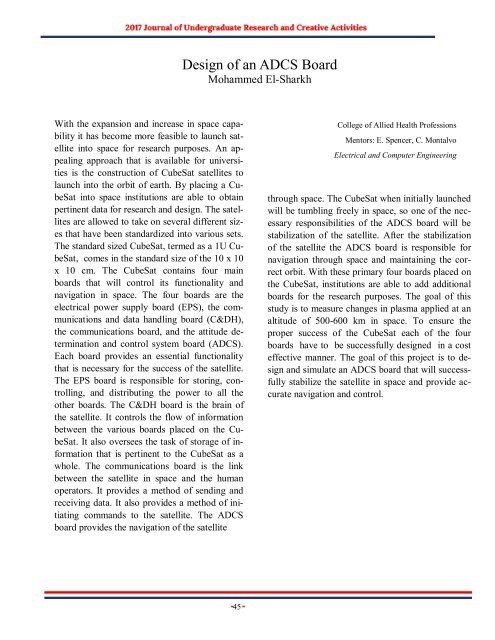JOURACA_SP_2017
You also want an ePaper? Increase the reach of your titles
YUMPU automatically turns print PDFs into web optimized ePapers that Google loves.
Design of an ADCS Board<br />
Mohammed El-Sharkh<br />
With the expansion and increase in space capability<br />
it has become more feasible to launch satellite<br />
into space for research purposes. An appealing<br />
approach that is available for universities<br />
is the construction of CubeSat satellites to<br />
launch into the orbit of earth. By placing a CubeSat<br />
into space institutions are able to obtain<br />
pertinent data for research and design. The satellites<br />
are allowed to take on several different sizes<br />
that have been standardized into various sets.<br />
The standard sized CubeSat, termed as a 1U CubeSat,<br />
comes in the standard size of the 10 x 10<br />
x 10 cm. The CubeSat contains four main<br />
boards that will control its functionality and<br />
navigation in space. The four boards are the<br />
electrical power supply board (EPS), the communications<br />
and data handling board (C&DH),<br />
the communications board, and the attitude determination<br />
and control system board (ADCS).<br />
Each board provides an essential functionality<br />
that is necessary for the success of the satellite.<br />
The EPS board is responsible for storing, controlling,<br />
and distributing the power to all the<br />
other boards. The C&DH board is the brain of<br />
the satellite. It controls the flow of information<br />
between the various boards placed on the CubeSat.<br />
It also oversees the task of storage of information<br />
that is pertinent to the CubeSat as a<br />
whole. The communications board is the link<br />
between the satellite in space and the human<br />
operators. It provides a method of sending and<br />
receiving data. It also provides a method of initiating<br />
commands to the satellite. The ADCS<br />
board provides the navigation of the satellite<br />
College of Allied Health Professions<br />
Mentors: E. Spencer, C. Montalvo<br />
Electrical and Computer Engineering<br />
through space. The CubeSat when initially launched<br />
will be tumbling freely in space, so one of the necessary<br />
responsibilities of the ADCS board will be<br />
stabilization of the satellite. After the stabilization<br />
of the satellite the ADCS board is responsible for<br />
navigation through space and maintaining the correct<br />
orbit. With these primary four boards placed on<br />
the CubeSat, institutions are able to add additional<br />
boards for the research purposes. The goal of this<br />
study is to measure changes in plasma applied at an<br />
altitude of 500-600 km in space. To ensure the<br />
proper success of the CubeSat each of the four<br />
boards have to be successfully designed in a cost<br />
effective manner. The goal of this project is to design<br />
and simulate an ADCS board that will successfully<br />
stabilize the satellite in space and provide accurate<br />
navigation and control.<br />
45

















